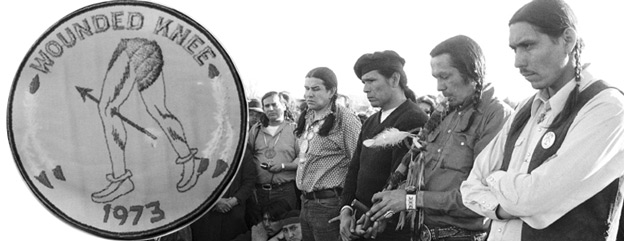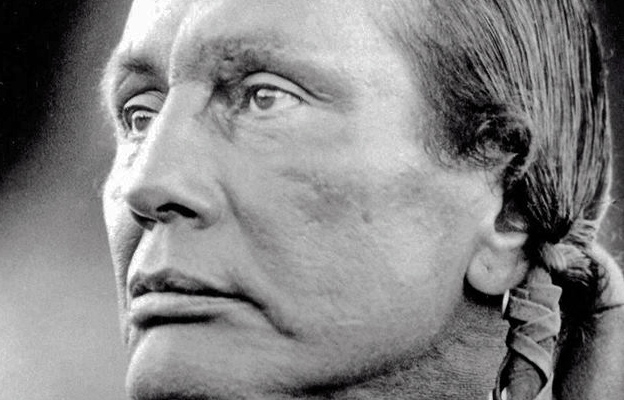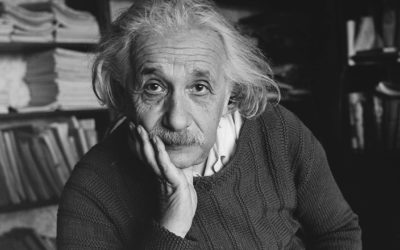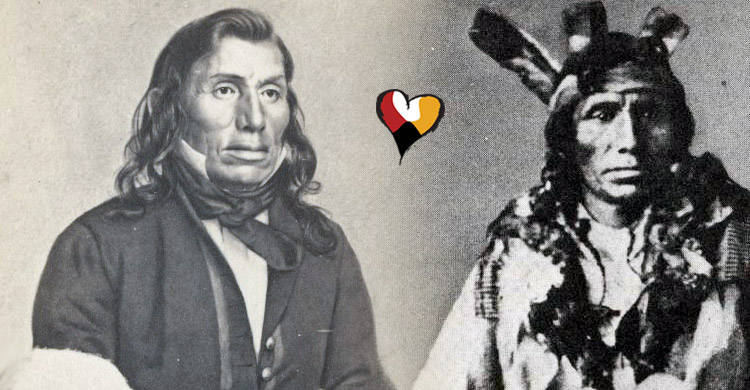Russell Means was an Oglala Lakota activist for the rights of American Indian people.
Russell Means (November 10, 1939 – October 22, 2012) became a prominent member of the American Indian Movement (AIM) after joining the organization in 1968 and helped organize notable events that attracted national and international media coverage.
Russell Means has lived a life like few others in this century – revered for his selfless accomplishments and remarkable bravery. He was born into a society and guided by a way of life that gently denies the self in order to promote the survival and betterment of family and community.
His culture is driven by tradition, which at once links the past to the present.
“If I want my people to be free, Americans have to be free.”
~Russell Means
Russell Means was once called the “biggest, baddest, meanest, angriest, most famous American Indian activist of the late 20th century.” He led a 71-day armed standoff in 1973 against federal agents at Wounded Knee, a tiny hamlet in the heart of South Dakota’s Pine Ridge Reservation.
It is considered to be one of his most famous act of defiance, however, occurred at Wounded Knee on February 27, 1973. Responding to the numerous murders perpetrated by puppet tribal governments and the extreme conditions of oppression, the takeover at Wounded Knee revisited the sight of the American Indian Wounded Knee massacre at the hands of U.S. soldiers in 1890.
Ever vigilant for his cause, Russell Means has been lauded by the international community for his tireless efforts. Later, he used film as a vehicle for his advocacy, thus enabling him to use different means to communicate his vital truths.
Through the power of media, his vision was to create peaceful and positive images celebrating the magic and mystery of his American Indian heritage. In contemplating the fundamental issues about the world in which we live, he was committed to educating all people about our most crucial battle-the preservation of the earth.

Means joined “The Longest Walk” in 1978 to protest a new tide of anti-Indian legislation including the forced sterilization of Indian women. Following the walk, the U.S. House of Representatives passed a resolution saying that national policy was to protect the rights of Indians, “to believe, express and exercise their traditional religions, including but not limited to access to sites, use and possession of sacred objects, and the freedom to worship through ceremonials and traditional rites.”
Russell Means has been called the most famous American Indian since Sitting Bull and Crazy Horse by the Los Angeles Times and recognized as a natural leader with a fearless dedication and indestructible sense of pride.
He took pride in having instituted programs for the betterment of his people: notable, the Porcupine Health Clinic (the only non-government-funded clinic in Indian Country) and KILI radio, the first Indian owned radio station.
Today, one of his principal goals has been the establishment of a “Total Immersion School”, which is based on a concept created by the Maori people of New Zealand, where children are immersed in the language, culture, science, music, and storytelling of their own people.
Russell wanted to adapt this total immersion concept to the Indian way of life and philosophy which is taught from a perspective that will nurture a new generation of proud children educated in the context of their own heritage.
Russell Means has devoted his life to eliminating racism of any kind, and in so doing he leaves a historical imprint as the most revolutionary Indian leader of the late twentieth century. An inspirational visionary, Russell Means remains one of the most magnetic voices in America today.
Whether when he led a protest, fought for constitutional rights, starred in a motion picture, or performed his “rap-ajo” music, the message he delivered was consistent with the philosophy he lived by, which states:
“The Universe, which controls all life, has a female and male balance that prevalent throughout our Sacred Grandmother, the Earth. This balance has to be acknowledged and become the determining factor in all of one’s decisions, be the spiritual, social, healthful, educational or economical. Once the balance has become an integral part of one’s life, all planning, research, direct action and follow-up becomes a matter of course. The goals that were targeted become a reality on a consistent basis. Good things happen to good People; remember time is on your side.”
Born on South Dakota’s Pine Ridge Indian Reservation in 1939, Russell Means was the eldest son of Hank Means, an Oglala Lakota, and Theodora (Feather) Means, a full-blooded Yankton Sioux.
Shortly after the outbreak of WWII, his family moved to California, where he graduated from San Leandro High in 1958 and continued his formal education at Oakland City College and Arizona State.
Russell’s commitment to uplift the plight of his people escalated when he served as director of Cleveland’s American Indian Center. It was there he met Dennis Banks, co-founder of the American Indian Movement, and embarked upon a relationship that would rocket them both into national prominence.
Russell Means harshly criticizes the B.I.A and American Indian leadership on reservations
“Young people and Indian people need to know that we existed in the 20th Century. We need to know who our heroes are and to know what we have done and accomplished in this century other than what Olympic athletes Jim Thorpe and Billy Mills have done.”
~Russell Means
RUSSELL MEANS SHORT BIO:
- 1970 – Means became the first National Director of the American Indian Movement after founding a branch of AIM in Cleveland.
- 1970 – The siege of Mt. Rushmore, which catapulted Means to national attention and focused the media on the modern Indian rights movement.
- 1970 – Led the Thanksgiving Day demonstration at Plymouth Rock in which over 200 Indians seized the Mayflower, painted Plymouth Rock red and observed a national day of mourning.
- 1972 – Participated in the takeover of the Bureau of Indian Affairs Headquarters in Washington D.C. during the Nixon Administration.
- 1973 – Directed the legendary siege of Wounded Knee, the most famous Indian insurrection of the twentieth century.
- 1974 – 76 Hounded by the FBI, the federal government and various state governments for his activism, Means represented himself in twelve criminal trials and won an acquittal in each case.
- 1974 – All the Elders of the Lakotah Sioux Nation, at the 1st International Indian treaty Conference unanimously selected Russell Means as permanent trustee of the International Indian Treaty Council. Russell was further charged with the responsibility of establishing an office at or near the United Nations, in New York City and to oversee all business conducted by that office.
- 1977 – Assisted in creating the First International Conference pertaining to the sovereign rights of North, Central and South American Indians, which was sponsored by the United Nations in Geneva.
- 1977 – University Lecture tour of Switzerland.
- 1978 – Participated in “The Longest Walk” in which American Indians walked across the United States from San Francisco to Washington D.C. creating the largest, single-day, peaceful demonstration in Washington D.C. up to that time. As a result, the demonstration succeeded in blocking all anti – Indian legislation in Congress.
- 1979 – Served one year of a four-year prison sentence in the South Dakota State Prison at Sioux Falls before he was released on parole. The charge was “Riot to Obstruct Justice” following the police riot at the Sioux Falls courthouse. The law under which he was convicted was repealed as unconstitutionally vague BEFORE his sentencing. Pardoned by South Dakota Governor in 2003.
The 1980’s
- 1980 – Only convict in history to work for a U.S. Senator while serving time. He worked principally on water rights in the State of South Dakota. While on work release Russell held a press conference calling for the Cowboys and Indians to join forces in their respected struggles to keep their lands and their rights. Subsequently, agreed to the formation of the Black Hills Alliance. Through this alliance they fought against President Carter’s plan to turn the nearby five-state area into a national sacrifice area. Also, the Black Hills Alliance lobbied successfully, the SD State Legislature to call for a moratorium on all energy development in the Black Hills.
- 1981 – Founded Yellow Thunder Camp, a spiritual youth camp in the Black Hills. Means lived there for eight seasons, along with Indians and Whites, in the spirit of returning his people to the Black Hills, the Lakotah Nation’s Holy Land.
- 1982 – Founded KILI radio station on the Pine Ridge reservation, the first radio station owned and operated by American Indians.
- 1983 – Attended the United Nations Conference on freezing nuclear development in the world at Prague, Czechoslovakia. Gave two major addresses concerning “Religion and Nuclear Weapons” and the “International Trade Unions and Nuclear Development”.
- 1985 – At Pine Ridge, led the building of the first independent health clinic on any Indian reservation.
- 1985 – Russell Means was invited to participate in the first Peace Conference held between the Indians and the Sandinistas of Nicaragua held at the Presidential Palace in Bogotá, Columbia.
- 1985 – Attended an International Ecumenical Conference on Religion held in Tokyo, Japan and Seoul, South Korea where he gave the closing address.
- 1986 – Means went with a group of North American Indians and one newsman to the Atlantic Coast of Nicaragua at the invitation of the Miskito, Sumu and Rama Indians to investigate and document Sandinista atrocities against the Miskito Indians.
- 1987 – University Lecture tour of Spain.
- 1988 – Means is the first American Indian to run for the office of the Presidency of the United States. A major constituency of the Libertarian Party (the third largest in the U.S) drafted Means to seek the party’s nomination for President in the 1988 elections.
- 1989 – Spoke before the Basque National Legislature and met with the Mayor of San Sebastian in an attempt to stop the Spain/U.S.A. joint venture in building and sailing three replicas ships of Columbus’ voyage to a hemisphere inhabited by American Indians!
- 1990 – Visited Aotarora aka New Zealand to speak at the University of Auckland a tour with the Maori people and exchange information concerning their land struggles, international struggles for treaty rights and a comprehensive visit to their total immersion educational system.
The 1990’s
- In addition to Means’ career as an activist he is also a successful producer and Hollywood actor:
1990 – Special Correspondent for The first Jesse Jackson TV Show. - 1991 – Founded multi-media production company, T.R.E.A.T.Y. Productions.
- 1992 – Starred at the title character, Chingachgook, in The Last of the Mohicans.
- 1992 – Starred as the ghost of Jim Thorpe in Windrunner.
- 1992 – Means and the Colorado AIM led a peaceful coalition that stopped the Columbus Day parade in Denver which was to celebrate the 500th Anniversary of “Columbus discovery of America.”
- 1993 – Starred in Oliver Stone’s Natural Born Killers.
- 1993 – Hosted HBO Documentary Paha Sapa.
- 1993 – Featured in mystery game CD-ROM Under A Killing Moon.
- 1993 – Release of Means’ debut album Electric Warrior on SOAR Records.
- 1993 – Founded T.R.E.A.T.Y. Total Immersion Educational Endowment Fund as Chairman.
- 1994 – Starred as Chief in John Candy’s comedy Wagons East.
- 1995 – Co-wrote the screenplay Wounded Knee, 1973 with Bayard Johnson.
- 1995 – Starred as Sitting Bull in the CBS mini-series Buffalo Girls.
- 1995 – Provided the voice for Chief Powhatan in Disney’s animated feature Pocahontas.
- 1995 – Special Appearance as Arrow Head in Hallmark Hall of Fame’s Pathfinder.
- 1995 – Wrote Where White Men Fear to Tread, The Autobiography of Russell Means, with Marvin J.Wolf published by St. Martin’s Press October 1995.
- 1996 – Founded The American Indian Music Company.
- 1996 – Release of Means’ second album The Radical on the American Indian Music Co. label.
- 1996 – Starred as Mudjekeewis in The Song of Hiawatha.
- 1996 – Guest Appearance on Walker, Texas Ranger.
- 1996 – Guest Appearance on Touched By An Angel.
- 1996 – Co-wrote the script The Longest War with Bayard Johnson.
- 1996 – Participated with the United Nations Commission on Human Rights in Geneva, Switzerland on promoting the rights of indigenous peoples throughout the world through a document presented to the Commission entitled “Declaration of Human Rights of Indigenous Peoples”.
- 1997 – Began serving on the Advisory Board of the Race Relations Institute.
- 1997 – Guest Appearance on Profiler.
- 1997 – Starred as Washakie in Wind River.
- 1998 – 1st Art Show of original paintings by Russell Means in conjunction with Gines Serran-Pagan in Santa Monica, CA.
- 1998 – Guest Appearance on Nash Bridges (two episodes).
- 1998 – Co-starred in Black Cat Run HBO, an original movie.
- 1998 – Co-wrote the screenplay Rising from the Ashes with Bayard Johnson.
- 1999 – Narrator PBS Documentary Keeping the Spirit Alive.
- 1999 – The Russell Means Commentary (West coast Cable).
- 1999 – Guest on Politically Incorrect.
- 1999 – Guest on the Roseanne Show.
- 1999 – Billy Two Feathers in Thomas and the Magic Rail Road.
- 1999 – Participated in Ecuador’s 1st Indigenous Conference on Constitutional Rights and was responsible for funding to maintain the Indigenous Peoples land base and the natural resources of their homeland surrounding the headwaters of the Amazon.
- 1999 – First Amendment Rights protest and arrest at white Clay, NE, protesting liquor store and illegal operations on the border of the Pine Ridge Sioux Indian reservation.
The 2000’s
- 2000 – 2nd Art Show of original paintings by Russell Means, Southampton, NY.
- 2000 – Protest of Columbus Day Parade and arrested in Denver, CO while exercising First Amendment Right against Hate Speech.
- 2000 – Board Member of the Natural Spirit Foundation, which funds American Indian self-help and cultural projects in Indian Country.
- 2000 – Visited and ongoing work relationship with the Chamoru People of Guam regarding “Vote against Statehood”, “Vote for Independence”.
- 2000 – Visited and worked with Kanaka Maoli, the indigenous Hawaiians and their struggles to achieve Independent Nation status.
- 2001 – Co-starred as Joe in Cowboy Up.
- 2001 – Guest Appearance on Family Law.
- 2001 – Starred as Chief in 29 Palms.
- 2002 – Founded The Independent Coalition party in New Mexico.
- 2002 – Exploratory Campaign for Governor State of New Mexico.
- 2002 – Candidate for President of the Oglala Lakotah Sioux Nation.
- 2003 – Received Pardon from South Dakota Governor for a 1974 Felony offense of Public Peace-Riot.
- 2003 – Cameo appearance in the feature film The Last Shot.
- 2003 – Co-writing Matriarchy, Beauty and Balance to be published 2007.
- 2003 – Russell Means’ Indian Killer series w/narratives, Bergamot Station Art Show, Santa Monica, CA.
- 2004 – Guest Appearance on HBO’s Curb Your Enthusiasm.
- 2004 – Starred as Bud in feature film Black Cloud.
- 2004 – Doctorate Degree in Indigenous Studies – Sinte Gleska University.
- 2005 – Senior Law Partner – Red Cloud Law Firm.
- 2005 – Lecture tour in Italy.
- 2005 – Co-starred as Grandpa in the feature film Unearthed.
- 2005 – Co-wrote Wounded Knee 1973 to be published in 2007.
- 2005 – Addressed an audience of 1.4 million at “The Millions More Movement”, Washington D.C.
- 2005 – Starred at the title character, Pathfinder in feature film Pathfinder.
- 2006 – Co-starred as Dace in feature film Intervention.
- 2006 – Lecture tour in Australia.
- 2006 – Dedication of the First Total Immersion School in the Lakota Culture -Pine Ridge, SD.
- 2007 – Participated in a 7 continent International Art Show-Paris, France.
- 2007 – Led Lakotah Freedom-unilateral withdrawal of Treaties and agreements with the U.S.
SOURCE: Based on materials from http://www.russellmeansfreedom.com






